
Now demolished, the former mile-long, U-shaped K-25 Building, pictured above, was once used to enrich uranium for atomic weapons and commercial nuclear power plants. Located in west Oak Ridge, the site could become part of a new Manhattan Project National Historical Park. There is a separate effort to preserve K-25’s history; that work could be incorporated into the new park. (Photo courtesy of U.S. Department of Energy)
It was once the world’s largest building under one roof and part of the one of the largest industrial projects ever, a top-secret program to build the world’s first atomic weapons in World War II.
Today the building is gone—demolition was completed in December 2013—but the stories of what took place inside the former mile-long, U-shaped K-25 Building could live on in a replica equipment building, viewing tower, and history center.
And K-25 could become part of a new Manhattan Project National Historical Park approved by Congress in December and signed into law by President Barack Obama on December 19. The 14-page bill was the culmination of 15 years of work, said Colin Colverson, Manhattan Project Park lead in the U.S. Department of Energy’s Oak Ridge Office.
The law recognizes the Manhattan Project as one of the most significant events in U.S. history, with assets and history that must be preserved. It’s considered one of the top scientific achievements of the 20th century, and Oak Ridge residents still marvel at how quickly the three local sites (K-25, X-10, and Y-12) were built and began operating in all-out race to build an atomic bomb before Germany.
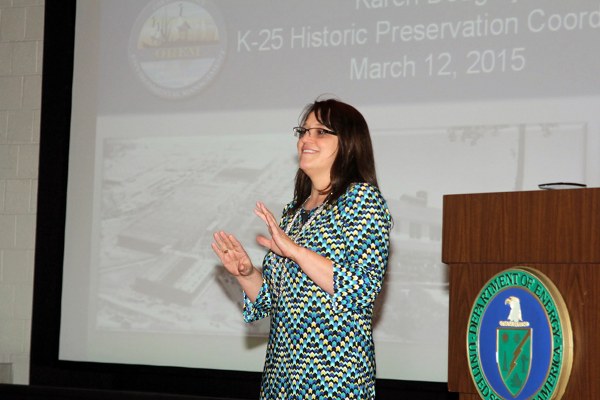
Karen Doughty of DOE’s Oak Ridge Office of Environmental Management talks about K-25 historic preservation work during the 18th Annual Dick Smyser Community Lecture Series, which was jointly sponsored by Friends of ORNL and the Oak Ridge Heritage and Preservation Association. The lecture was March 12 at the American Museum of Science and Energy. (Photo by D. Ray Smith)
Officials from DOE and the National Park Service, which is part of the Department of Interior, are now visiting the three sites included in the Manhattan Project National Historical Park: Oak Ridge; Los Alamos, New Mexico; and Hanford, Washington. Their first stop is in Oak Ridge this week. As part of the planning process, they’ll have a community open house hosted by the City of Oak Ridge on Thursday, March 26, from 10 to 11 a.m. in the Oak Ridge Civic Center A/B Room.
Besides the Thursday open house, the visit is expected to include other stops and meetings with local leaders.
Karen Doughty of DOE’s Oak Ridge Office of Environmental Management gave an update on the K-25 historic preservation work earlier this month during the 18th Annual Dick Smyser Community Lecture Series.
The K-25 Building is one of four DOE facilities in Oak Ridge that are eligible to be included in the new national park. The other three are Building 9731, a pilot plant at the Y-12 National Security Complex; Building 9204-3, also known as Beta 3, at Y-12; and the Graphite Reactor at Oak Ridge National Laboratory.
But planning to preserve K-25 history began even before the national park legislation was passed.
“Our intention was to do it whether there was a park or not,” Doughty said. “This is a separate effort.”
Oak Ridge City Manager Mark Watson said the K-25 History Center is a separate agreement, but it is relevant to the National Park Service, which is a consulting party on the historic preservation work.
“It’s important that that blend in,” Watson said of the K-25 preservation project and the new national park.
Colverson said every eligible DOE site such as K-25 is subject to the review of the Secretary of Energy and Secretary of Interior for inclusion in the new park. The B Reactor at Hanford is definitely included, but everything else is subject to approval, he said.
There are some access issues, including at Oak Ridge and Los Alamos. The ORNL and Y-12 buildings, for example, are “inside the fence,” meaning permission is required to enter the sites and guards control who enters through the gates.
The K-25 building was once used to enrich uranium for nuclear weapons and commercial power plants through a process known as gaseous diffusion. Officials and contractors say it helped win the Cold War.
Preservationists had lobbied for years to save part of the giant K-25 Building, specifically its North Tower, but an agreement announced in August 2012 cleared the way for the complete demolition of the building. However, the agreement also called for the replica equipment building and viewing tower, proposed the history center on the second floor of a city-owned fire station at the K-25 site (now known as Heritage Center), and provided a $500,000 grant for the former Alexander Inn, which is being converted into an assisted living center and could become part of the park.
The K-25 Building site could become part of a hub-and-spoke park system in Oak Ridge, where the hub is in the center of town at the Oak Ridge Municipal Building, Civic Center, Public Library, and American Museum of Science and Energy, and the spokes are the sites such as K-25 and the buildings at ORNL and Y-12.
Some of the work called for under the 2012 K-25 agreement has been done, including the awarding of the Alexander Inn grant, obtaining the services of a professional site design team and museum professional, listing of available unclassified documents, and creating an inventory of equipment and artifacts.
Doughty said there are 700 artifacts in storage and available for historic preservation. A K-25 story timeline has been started, a virtual museum outline developed, and a Web design concept completed. It could be demonstrated to consulting parties late this spring.
The “footprint,” or slab, of the K-25 Building has been preserved, and sampling and analysis conducted to determine the contamination levels on and beneath the slab. Officials are evaluating alternatives and the costs associated with leaving, covering, or removing the slab, Doughty said. The results will be incorporated into the design.
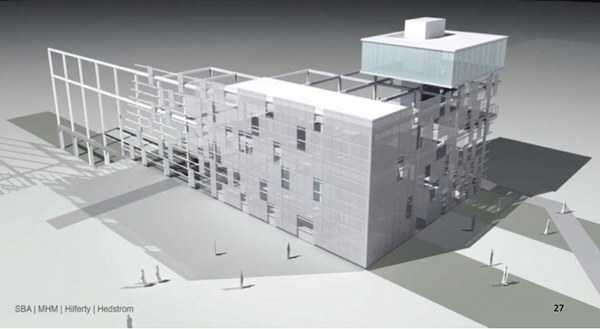
The image above shows what the K-25 Equipment Building and Viewing Tower could look like. (All remaining images courtesy DOE)
The Equipment Building would replicate the exterior appearance of K-25 and house a representative cross-section of gaseous diffusion equipment, with a design structurally similar to K-25.
The Viewing Tower would allow visitors to view the K-25 “footprint,” and it could either stand alone or be part of the Equipment Building.
A conceptual plan has been drafted for the Viewing Tower and Equipment Building, which could be a short walk away from the History Center at the open end of K-25’s U.
The History Center, which could be 7,500 square feet on the second floor of the nearby fire station, would focus on the Manhattan Project. Oral histories could be added, and visitors could access the K-25 Virtual Museum. A conceptual design has also been drafted for the History Center, and it includes a theater, changing gallery, and exhibits.
There could be 12 wayside exhibits around the K-25 Building site and walking or biking trails, according to Doughty’s presentation. Parts of the slab could alternate with long and short switchgrass.

This image shows what exhibits on the cell floor could look like in the proposed K-25 Equipment Building and Viewing Tower.
A dozen parties are consulting on the project, including DOE Environmental Management, National Park Service, Atomic Heritage Foundation, City of Oak Ridge, Oak Ridge Heritage and Preservation Association, East Tennessee Preservation Alliance, Oak Ridge Site Specific Advisory Board, and Community Reuse Organization of East Tennessee, and state and federal historic preservation offices.
Doughty said comments on the conceptual design are being addressed, and preliminary design is expected to begin late this spring. The slab feasibility study needs to be finalized, and the virtual museum will be rolled out, she said.
The total cost of the project has been estimated at $17.6 million.
But funding is a challenge, Doughty said. Progress has been made, but there is no money included in the president’s budget for the fiscal year that starts in October (Fiscal Year 2016). The agreement’s execution plan had called for $8 million in funding for FY 16. (The plan had called for $6.2 million this year, but $2.1 million was authorized.) But it’s not yet clear how Congress might adjust the president’s proposed budget for the next fiscal year.
The legislation passed by Congress last year establishes the park no later than one year after enactment. During that time, the U.S. Department of Energy and Department of Interior need to enter an agreement on their roles and responsibilities. They are expected to sign that before December 19, 2015.
Companies helping on the K-25 preservation project are Smee + Busby Architects (lead architect), McCarty Holsaple McCarty (project management), Hilferty and Associates (museum professional), and Hedstrom Design (landscape architect). Among other things, they’ve toured a gaseous diffusion building at K-25 and gone up high on a lift to see what the view might be like from a viewing tower.
See Doughty’s presentation here:Â K-25 Historic Preservation AMSE Presentation March 12, 2015.
More information will be added as it becomes available.
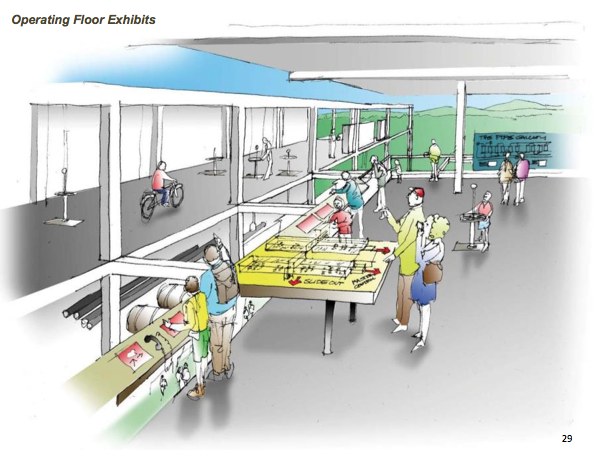
An image showing what the operating floor exhibits could look like at the K-25 Equipment Building and Viewing Tower.

The K-25 History Center could be on the second floor of the city-owned fire station at Heritage Center, which is circled in red. The Equipment Building and Viewing Tower could be to the left and a bit north of the fire station. The large slab areas underneath the east and west wings of the former K-25 Building are visible in the left and right background.

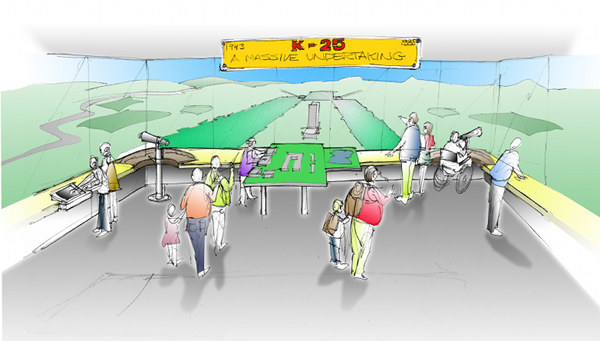
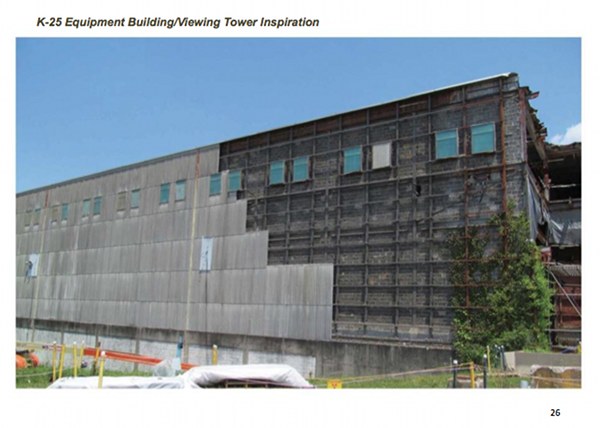
Leave a Reply